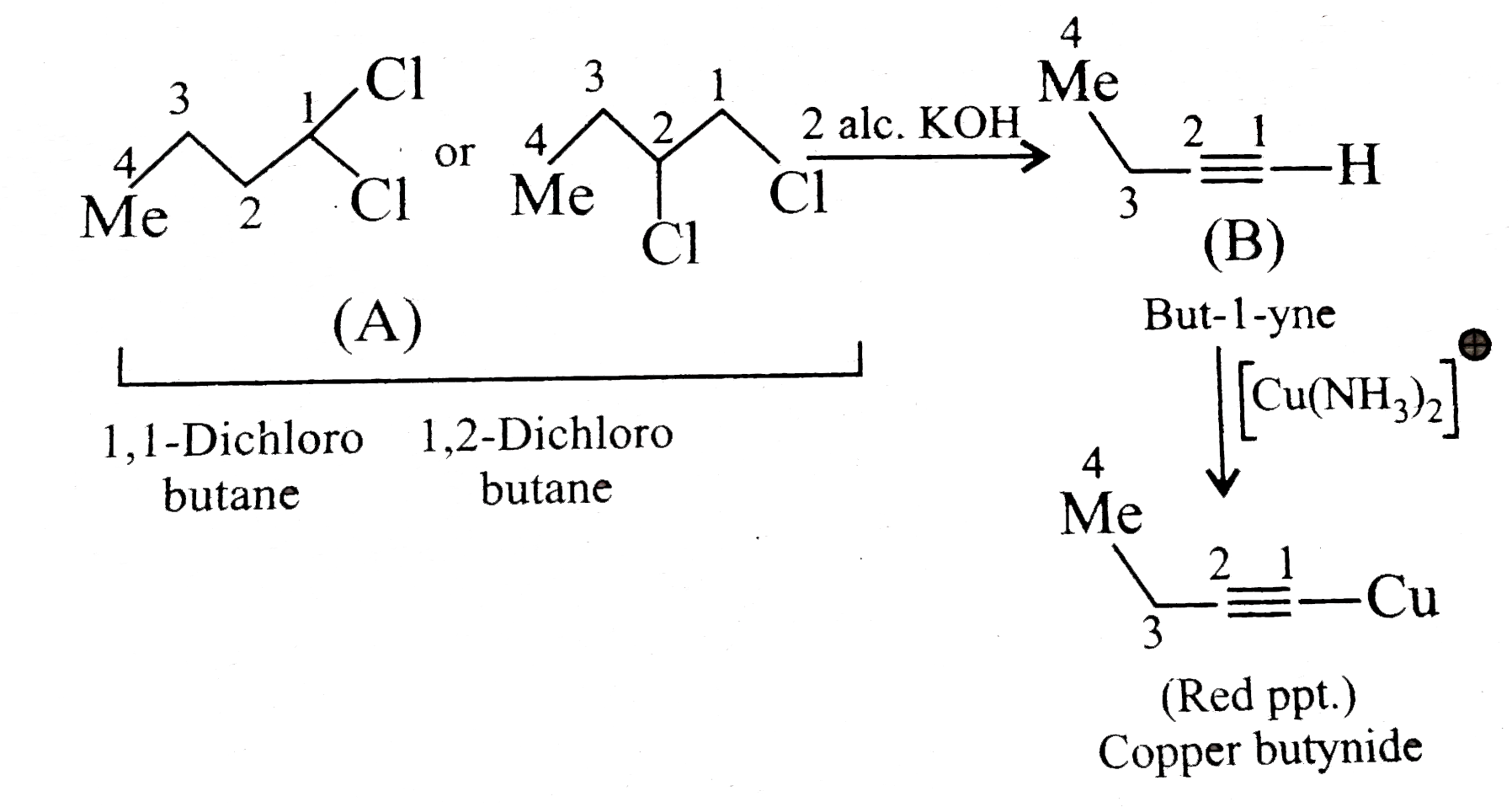With alcoholic potash, C4H8Cl2 (A) gives C4H6 (B), which reacts with ammoniacal cuprous chloride. Identify the compounds (A) and (B).
Topper's Solved these Questions
- BOOK - CENGAGE CHEMISTRYCHAPTER - ALKYNESEXERCISE - Exercises (Linked Comprehension Type)51videos
ALKYNES
- BOOK - CENGAGE CHEMISTRYCHAPTER - ALKYNESEXERCISE - Exercises (Multiple Correct Answers Type)25videos
ALKYNES
- BOOK - CENGAGE CHEMISTRYCHAPTER - ALKYNESEXERCISE - Solved Examples24videos
ALKYNES
- BOOK - CENGAGE CHEMISTRYCHAPTER - ALKENES AND ALKADIENESEXERCISE - Single correct Answer14videos
ALKENES AND ALKADIENES
- BOOK - CENGAGE CHEMISTRYCHAPTER - APPENDIX - INORGANIC VOLUME 1EXERCISE - chapter-7 Single correct answer1videos
APPENDIX - INORGANIC VOLUME 1
Similar Questions
A dihalogen derivative (A) of a hydrocarbon having two carbon atoms reacts with alcoholic potash and forms another hydrocarbon which gives a red precipitate with ammoniacal cuprous chloride. Compound A gives an aldehyde when treated with aqueous KOH. Write down the name and formula for the organic compound.
View SolutionOn nuclear chlorination, C8,H10(A) gives a product (B) which may be oxidised to C8H5O4Cl(C).(A) may alos be chlorinated to give C8H8Cl2(D),C8H6Cl4(E), and C8H4Cl6(F).(D),(E) and (F) on hydrolysis give halogen-free compounds (G),(H), and (I), respectively. With CrCO2Cl2,(A) gives C8H6O4 which is identiacla with (I) . Identify wtih (I). Identify the varioius compounds (A) to (J).
View Solution
Knowledge Check
- Question 1 - Select One
The unsaturated hydrocarbon obtained by the reaction of a dihalogen derivative with alcoholic potash gives a red precipitate with ammoniacal cuprous chloride. The dihalogen derivative gives propanal on heating with aqueous potash. The dihalogen derivative is:
A1,1–DichloropropaneB1,2–DichloropropaneC2,2–DichloropropaneD1,4–Dichloropropane - Question 2 - Select One
The unsaturated hydrocarbon obtained by the reaction of a dihalogen derivative with alcoholic potash gives a red precipitate with ammoniacal cuprous chloride. The dihalogen derivative gives propanal on heating with aqueous potash. The dihalogen derivative is:
A1,1–DichloropropaneB1,2–DichloropropaneC2,2–DichloropropaneD1,4–Dichloropropane - Question 3 - Select One
A gas decolourises KMnO4 solution but gives no precipitate with ammoniacal cuprous chloride is
AEthaneBMethaneCEtheneDAcetylene
An organic compound (A) (C5H7OCl) reacts rapidly with ethanol to give (B) (C7H12O2). (A) also reacts with water to produce an acid which reacts with bromine to give (C ) (C5H8Br2O2). (B) on boiling with H2SO4 forms an acid (D). When (D) is oxidised with KMnO4 an acid (E ) (C4H6O3) is produced. On mild heating, (E ) gives (F) (C3H6O) which cannot be oxidised by ammoniacal AgNO3. Identify the compounds (A) to (F).
View SolutionCompund (A)C8H9 Br gives a white precipitate when warmed with alcoholic AgNO3 Oxidation of (A) gives an acid (B) C8H6O4 (B) easily anhydride on heating Identify the compound (A) .
View SolutionCompound (A) ,C8H9Br gives a white precipitate when warmed with alcoholic AgNO3 Oxidation of (A) gives an acid (B) C8H6O4 (B) easily forms anhydride on heating Identify the compound (A)
View SolutionCompound (A) C8H9Br, gives a white precipitate when warmed with alcoholic AgNO3. Oxidation of (A) gives an acid (B),C8H6O4. (B) easily forms anhydride on heating. Identify the compound (A)
View SolutionCompound (A) ,C8H9Br gives a white precipitate when warmed with alcoholic AgNO3 Oxidation of (A) gives an acid (B) C8H6O4 (B) easily forms anhydride on heating Identify the compound (A)
View Solution


